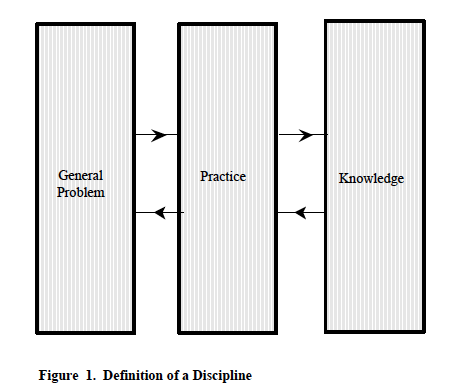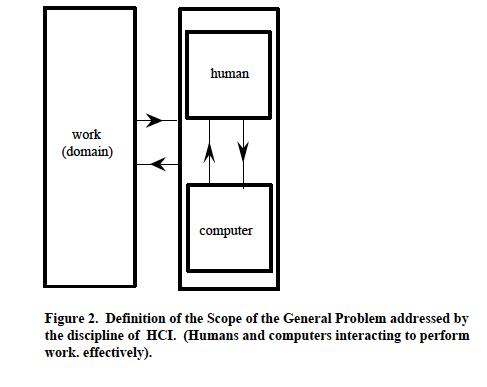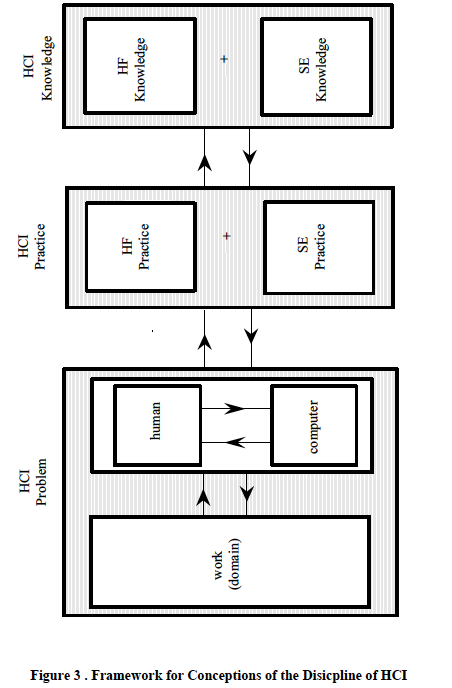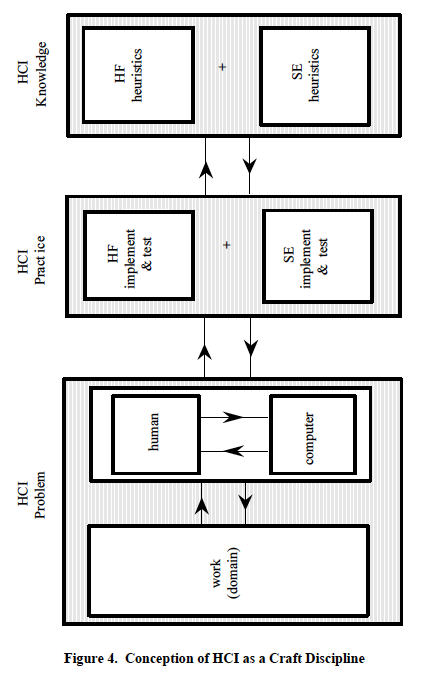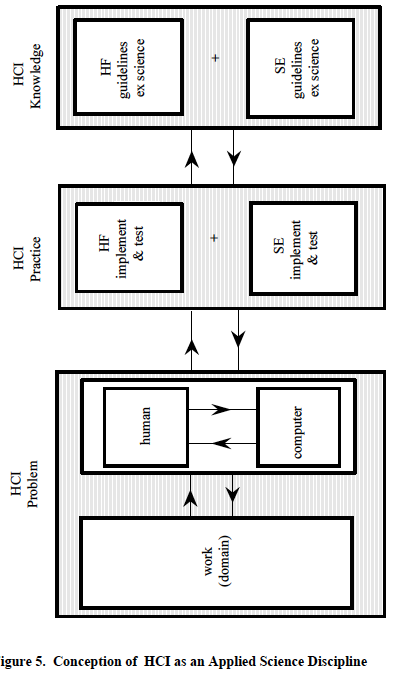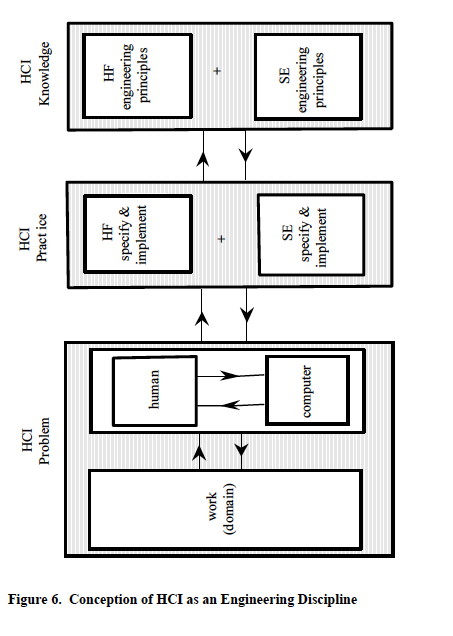3.4 Dowell and Long (1989) – HCI Engineering Knowledge – Short Version
Dowell and Long (1989) – Short Version
Towards a Conception for an Engineering Discipline of Human Factors
Short version
John Dowell and John Long
Ergonomics Unit, University College London,
26, Bedford Way, London. WC1H 0AP.
Abstract ……… The paper is in two parts. Part I examines the potential for Human Factors to formulate engineering principles. …….. A conception would provide the set of related concepts which both expressed the general design problem more formally, and which might be embodied in engineering principles.
In P. Barber and J. Laws (ed.s) Special Issue on Cognitive Ergonomics, Ergonomics, 1989, vol. 32, no. 11, pp. 1613-1536.
Part I. Requirement for Human Factors as an Engineering Discipline of Human-Computer Interaction
1.1 Introduction;
1.2 Characterization of the human factors discipline;
1.3 State of the human factors art;
1.4 Human factors engineering;
1.5 The requirement for an engineering conception of human factors.
1.1 Introduction
Assessment of contemporary HF (Section 1.3.) concludes that its practices are predominantly those of a craft. Shortcomings of those practices are exposed which indict the absence of support from appropriate formal discipline knowledge. This absence prompts the question as to what might be the formal knowledge which HF could develop, and what might be the process of its formulation. By comparing the HF general design problem with other, better understood, general design problems, and by identifying the formal knowledge possessed by the corresponding disciplines, the potential for HF engineering principles is suggested (Section 1.4.).
However, a pre-requisite for the formulation of any engineering principle is a conception. A conception is a unitary (and consensus) view of a general design problem; its power lies in the coherence and completeness of its definition of the concepts which can express that problem. Engineering principles are articulated in terms of those concepts. Hence, the requirement for a conception for the HF discipline is concluded (Section 1.5.).
1.2. Characterisation of the Human Factors Discipline
Most definitions of disciplines assume three primary characteristics: a general problem; practices, providing solutions to that problem; and knowledge, supporting those practices.
1.3. State of the Human Factors Art
It would be difficult to reject the claim that the contemporary HF discipline has the character of a craft …….. Characteristic of a craft, the execution and success of its practices in systems development depends principally on the expertise, guided intuition and accumulated experience which the practitioner brings to bear on the design problem.
……..
The dogma of HF as necessarily a craft whose knowledge may only be the accrued experience of its practitioners, is nowhere presented rationally.
……Third, HF practices are inefficient. Each development of a system requires the solving of new problems by implementation then testing. There is no formal structure within which experience accumulated in the successful development of previous systems can be recruited to support solutions to the new problems, except through the memory and intuitions of the designer. These may not be shared by others, except indirectly (for example, through the formulation of heuristics), and so experience may be lost and may have to be re-acquired (Long and Dowell, 1989).
The guidance may be direct – by the designer’s familiarity with psychological theory and practice, or may be indirect by means of guidelines derived from psychological findings. In both cases, the guidance can offer only advice, which must be implemented then tested to assess its effectiveness. Since the general scientific problem is the explanation and prediction of phenomena, and not the design of artifacts, the guidance cannot be directly embodied in design specifications which offer a guarantee with respect to the effectiveness of the implemented design.
…….. These four deficiencies are endemic to the craft nature of contemporary HF practice. They indict the tacit HF discipline knowledge consisting of accumulated experience embodied in procedures, even where that experience has been influenced by guidance offered by the science of psychology .Because the knowledge is tacit (i.e., implicit or informal), it cannot be operationalised, and hence the role of HF in systems development cannot be planned as would be necessary for the proper integration of the knowledge. Without being operationalised, its knowledge cannot be tested, and so the efficacy of the practices it supports cannot be guaranteed. Without being tested, its knowledge cannot be generalised for new applications and so the practices it can support will be inefficient. Without being operationalised, testable, and general, the knowledge cannot be developed in any structured way as required for supporting the systematic and intentional progress of the HF discipline.
It would be incorrect to assume the current absence of formality of HF knowledge to be a necessary response to the indeterminism of human behaviour………. The extent to which human behaviour is deterministic for the purposes of designing interactive computer-based systems needs to be independently established. Only then might it be known if HF discipline knowledge could be formal.
1.4. Human Factors Engineering Principles
HF has been viewed earlier (Section 1.2.) as comparable to other disciplines which address general design problems: for example, Civil Engineering and Health Administration. The nature of the formal knowledge of a future HF discipline might, then, be suggested by examining such disciplines. The general design problems of different disciplines, however, must first be related to their characteristic practices, in order to relate the knowledge supporting those practices.
……..
there exists no pre-ordained relationship between the formality of a discipline’s knowledge and the hardness of its general design problem. In particular, the practices of a (craft) discipline supported by experience – that is, by informal knowledge – may address a hard problem. But also, within the boundary of determinism, that discipline could acquire formal knowledge to support specification as a design practice.
…….. Generally, the established engineering disciplines possess formal knowledge: a corpus of operationalised, tested, and generalised principles. Those principles are prescriptive, enabling the complete specification of design solutions before those designs are implemented (see Dowell and Long, 1988b). This theme of prescription in design is central to the thesis offered here.
Engineering principles can be substantive or methodological (see Checkland, 1981; Pirsig, 1974). Methodological Principles prescribe the methods for solving a general design problem optimally. For example, methodological principles might prescribe the representations of designs specified at a general level of description and procedures for systematically decomposing those representations until complete specification is possible at a level of description of immediate design implementation (Hubka, Andreason and Eder, 1988). Methodological principles would assure each lower level of specification as being a complete representation of an immediately higher level.
Substantive Principles prescribe the features and properties of artefacts, or systems that will constitute an optimal solution to a general design problem. As a simple example, a substantive principle deriving from Kirchoff’s Laws might be one which would specify the physical structure of a network design (sources, resistances and their nodes etc) whose behaviour (e.g., distribution of current) would constitute an optimal solution to a design problem concerning an amplifier’s power supply.
1.5. The Requirement for an Engineering Conception for Human Factors
The contemporary HF discipline does not possess either methodological or substantive engineering principles. The heuristics it possesses are either ‘rules of thumb’ derived from experience or guidelines derived from psychological theories and findings. Neither guidelines nor rules of thumb offer assurance of their efficacy in any given instance, and particularly with regard to the effectiveness of a design. The methods and models of HF (as opposed to methodological and substantive principles) are similarly without such an assurance. Clearly, any evolution of HF as an engineering discipline in the manner proposed here has yet to begin. There is an immediate need then, for a view of how it might begin, and how formulation of engineering principles might be precipitated.
……..Such a conception is a unitary (and consensus) view of the general design problem of a discipline. Its power lies in the coherence and completeness of its definition of concepts which express that problem. Hence, it enables the formulation of engineering principles which embody and instantiate those concepts. A conception (like a paradigm) is always open to rejection and replacement.
…….. It is inconceiveable that a formulation of HF engineering principles might occur whilst there is no consensus understanding of the concepts which they would embody. Articulation of a conception must then be a pre-requisite for formulation of engineering principles for HF.
Part II. Conception for an Engineering Discipline of Human Factors
2.1 Conception of the human factors general design problem;
2.2 Conception of work and user; 2.2.1 Objects and their attributes; 2.2.2 Attributes and levels of complexity; 2.2.3 Relations between attributes; 2.2.4 Attribute states and affordance; 2.2.5 Organisations, domains (of application)2.2.6 Goals; 2.2.7 Quality; 2.2.8 Work and the user; and the requirement for attribute state changes;
2.3 Conception of the interactive worksystem and the user; 2.3.1 Interactive worksystems; 2.3.2 The user as a system of mental and physical human behaviours; 2.3.3 Human-computer interaction; 2.3.4 On-line and off-line behaviours; 2.3.5 Human structures and the user; 2.3.6 Resource costs and the user;
2.4 Conception of performance of the interactive worksystem and the user;
2.5 Conclusions and the prospect for Human Factors engineering principles
2.5. Conclusions and the Prospect for Human Factors Engineering Principles
…….. The extent to which HF engineering principles might be realiseable in practice remains to be seen. It is not supposed that the development of effective systems will never require craft skills in some form, and engineering principles are not seen to be incompatible with craft knowledge, particularly with respect to their instantiation (Long and Dowell, 1989). At a minimum, engineering principles might be expected to augment the craft knowledge of HF professionals. Yet the great potential of HF engineering principles for the effectiveness of the discipline demands serious consideration. References Ashby W. Ross, (1956), An Introduction to Cybernetics. London: Methuen.
Bornat R. and Thimbleby H., (1989), The Life and Times of ded, Text Display Editor. In J.B. Long and A.D. Whitefield (ed.s), Cognitive Ergonomics and Human Computer Interaction. Cambridge: Cambridge University Press.
Card, S. K., Moran, T., and Newell, A., (1983), The Psychology of Human Computer Interaction, New Jersey: Lawrence Erlbaum Associates.
Carey, T., (1989), Position Paper: The Basic HCI Course For Software Engineers. SIGCHI Bulletin, Vol. 20, no. 3.
Carroll J.M., and Campbell R. L., (1986), Softening up Hard Science: Reply to Newell and Card. Human Computer Interaction, Vol. 2, pp. 227-249.
Checkland P., (1981), Systems Thinking, Systems Practice. Chichester: John Wiley and Sons.
Cooley M.J.E., (1980), Architect or Bee? The Human/Technology Relationship. Slough: Langley Technical Services.
Didner R.S. A Value Added Approach to Systems Design. Human Factors Society Bulletin, May 1988. Dowell J., and
Long J. B., (1988a), Human-Computer Interaction Engineering. In N. Heaton and M . Sinclair (ed.s), Designing End-User Interfaces. A State of the Art Report. 15:8. Oxford: Pergamon Infotech.
Dowell, J., and Long, J. B., 1988b, A Framework for the Specification of Collaborative Research in Human Computer Interaction, in UK IT 88 Conference Publication 1988, pub. IEE and BCS.
Gibson J.J., (1977), The Theory of Affordances. In R.E. Shaw and J. Branford (ed.s), Perceiving, Acting and Knowing. New Jersey: Erlbaum.
Gries D., (1981), The Science of Programming, New York: Springer Verlag.
Hubka V., Andreason M.M. and Eder W.E., (1988), Practical Studies in Systematic Design, London: Butterworths.
Long J.B., Hammond N., Barnard P. and Morton J., (1983), Introducing the Interactive Computer at Work: the Users’ Views. Behaviour And Information Technology, 2, pp. 39-106.
Long, J., (1987), Cognitive Ergonomics and Human Computer Interaction. In P. Warr (ed.), Psychology at Work. England: Penguin.
Long J.B., (1989), Cognitive Ergonomics and Human Computer Interaction: an Introduction. In J.B. Long and A.D. Whitefield (ed.s), Cognitive Ergonomics and Human Computer Interaction. Cambridge: Cambridge University Press.
Long J.B. and Dowell J., (1989), Conceptions of the Discipline of HCI: Craft, Applied Science, and Engineering. In Sutcliffe A. and Macaulay L., Proceedings of the Fifth Conference of the BCS HCI SG. Cambridge: Cambridge University Press.
Marr D., (1982), Vision. New York: Wh Freeman and Co. Morgan D.G.,
Shorter D.N. and Tainsh M., (1988), Systems Engineering. Improved Design and Construction of Complex IT systems. Available from IED, Kingsgate House, 66-74 Victoria Street, London, SW1.
Norman D.A. and Draper S.W. (eds) (1986): User Centred System Design. Hillsdale, New Jersey: Lawrence Erlbaum;
Pirsig R., 1974, Zen and the Art of Motorcycle Maintenance. London: Bodley Head.
Rouse W. B., (1980), Systems Engineering Models of Human Machine Interaction. New York: Elsevier North Holland.
Shneiderman B. (1980): Software Psychology: Human Factors in Computer and Information Systems. Cambridge, Mass.: Winthrop.
Thimbleby H., (1984), Generative User Engineering Principles for User Interface Design. In B. Shackel (ed.), Proceedings of the First IFIP conference on Human-Computer Interaction. Human-Computer Interaction – INTERACT’84. Amsterdam: Elsevier Science. Vol.2, pp. 102-107.
van Gisch J. P. and Pipino L.L., (1986), In Search of a Paradigm for the Discipline of Information Systems, Future Computing Systems, 1 (1), pp. 71-89.
Walsh P., Lim K.Y., Long J.B., and Carver M.K., (1988), Integrating Human Factors with System Development. In: N. Heaton and M. Sinclair (eds): Designing End-User Interfaces. Oxford: Pergamon Infotech.
Wilden A., 1980, System and Structure; Second Edition. London: Tavistock Publications.
This paper has greatly benefited from discussion with others and from their criticisms. We would like to thank our collegues at the Ergonomics Unit, University College London and in particular, Andy Whitefield, Andrew Life and Martin Colbert. We would also like to thank the editors of the special issue for their support and two anonymous referees for their helpful comments. Any remaining infelicities – of specification and implementation – are our own
For more information, contact John Long


